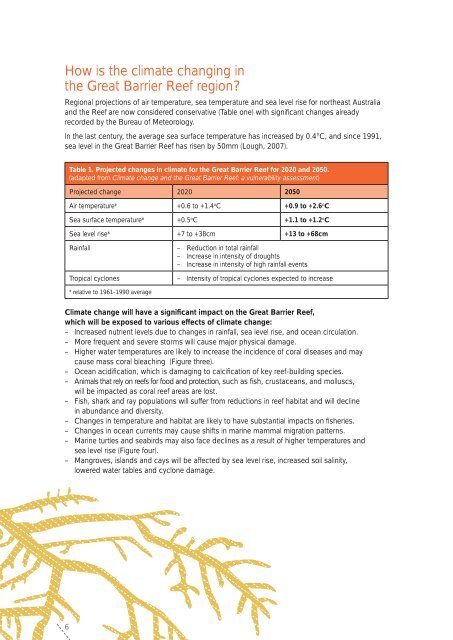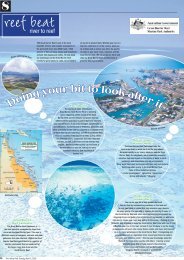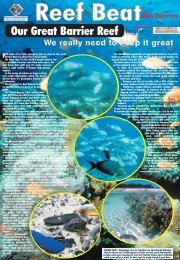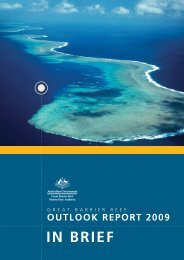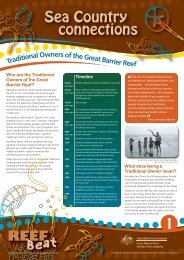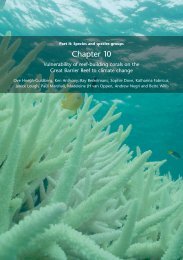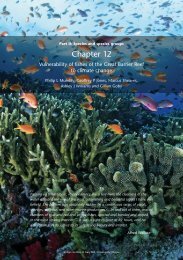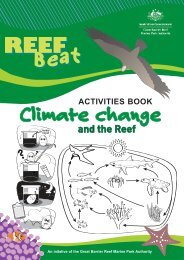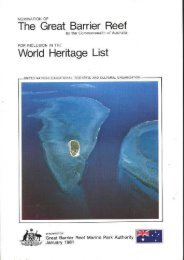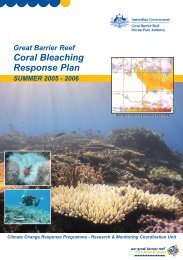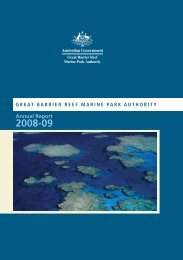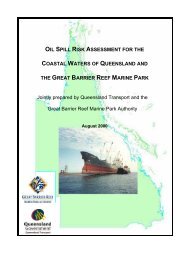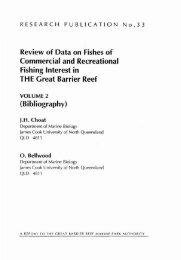Great Barrier Reef Tourism Climate Change Action Strategy 2009 ...
Great Barrier Reef Tourism Climate Change Action Strategy 2009 ...
Great Barrier Reef Tourism Climate Change Action Strategy 2009 ...
Create successful ePaper yourself
Turn your PDF publications into a flip-book with our unique Google optimized e-Paper software.
How is the climate changing in<br />
the <strong>Great</strong> <strong>Barrier</strong> <strong>Reef</strong> region?<br />
Regional projections of air temperature, sea temperature and sea level rise for northeast Australia<br />
and the <strong>Reef</strong> are now considered conservative (Table one) with signifi cant changes already<br />
recorded by the Bureau of Meteorology.<br />
In the last century, the average sea surface temperature has increased by 0.4°C, and since 1991,<br />
sea level in the <strong>Great</strong> <strong>Barrier</strong> <strong>Reef</strong> has risen by 50mm (Lough, 2007).<br />
Table 1. Projected changes in climate for the <strong>Great</strong> <strong>Barrier</strong> <strong>Reef</strong> for 2020 and 2050.<br />
(adapted from <strong>Climate</strong> change and the <strong>Great</strong> <strong>Barrier</strong> <strong>Reef</strong>: a vulnerability assessment)<br />
Projected change 2020 2050<br />
Air temperature* +0.6 to +1.4 o C +0.9 to +2.6 o C<br />
Sea surface temperature* +0.5 o C +1.1 to +1.2 o C<br />
Sea level rise* +7 to +38cm +13 to +68cm<br />
Rainfall<br />
Tropical cyclones<br />
* relative to 1961-1990 average<br />
–<br />
–<br />
–<br />
–<br />
Reduction in total rainfall<br />
Increase in intensity of droughts<br />
Increase in intensity of high rainfall events<br />
Intensity of tropical cyclones expected to increase<br />
<strong>Climate</strong> change will have a significant impact on the <strong>Great</strong> <strong>Barrier</strong> <strong>Reef</strong>,<br />
which will be exposed to various effects of climate change:<br />
– Increased nutrient levels due to changes in rainfall, sea level rise, and ocean circulation.<br />
– More frequent and severe storms will cause major physical damage.<br />
– Higher water temperatures are likely to increase the incidence of coral diseases and may<br />
cause mass coral bleaching (Figure three).<br />
– Ocean acidifi cation, which is damaging to calcifi cation of key reef-building species.<br />
– Animals that rely on reefs for food and protection, such as fi sh, crustaceans, and molluscs,<br />
will be impacted as coral reef areas are lost.<br />
– Fish, shark and ray populations will suffer from reductions in reef habitat and will decline<br />
in abundance and diversity.<br />
– <strong>Change</strong>s in temperature and habitat are likely to have substantial impacts on fi sheries.<br />
– <strong>Change</strong>s in ocean currents may cause shifts in marine mammal migration patterns.<br />
– Marine turtles and seabirds may also face declines as a result of higher temperatures and<br />
sea level rise (Figure four).<br />
– Mangroves, islands and cays will be affected by sea level rise, increased soil salinity,<br />
lowered water tables and cyclone damage.<br />
6


